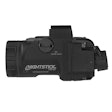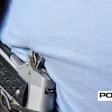Back in the late 1990s, a new polymer pistol called the HS 2000 hit the market. Made in Croatia by I.M. Metal, the HS 2000 suffered from poor marketing, a poor supply of holsters and accessories, and ultimately, poor sales.
A business analyst could tell you a variety of reasons why the HS 2000 failed to win the hearts of gun enthusiasts. But the people the pistol was supposed to appeal to, the gun enthusiasts themselves, will tell you that the leading reason the gun fell flat in the U.S. market was the magazine capacity restriction dictated by the Crime Bill of 1994, otherwise known as the Assault Weapon Ban. This hurt sales in the civilian market, and a lack of civilian sales hindered efforts to market the pistol to law enforcement agencies.
In 2000, I.M. Metal decided that it once again wanted to go after the American market. But this time, the company’s management realized that it needed the help of a venerable American gun maker if it had any dream of success. I.M. Metal teamed up with Springfield Armory to market a new HS 2000.
The pistol is virtually unchanged except for the logos, but it’s a hit. The Springfield Armory XD Line launched in late 2000 with two four-inch barrel models: the XD9 chambered in 9mm and the XD40 chambered in .40 S&W. Now the line has expanded to include tactical, duty, and subcompact pistols available in .9mm, .40 S&W, .357 SIG, and .45 Glock Auto Pistol (G.A.P.). Demand for some of the pistols has been so high that back orders were in the thousands a couple of years ago. Not a bad turn around for a pistol that almost went the way of the Edsel.
Why the sudden turnaround in sales of the XD Pistol? I think it has a lot to do with the Springfield name. Throughout American history it’s stood for quality. Also, the magazine capacity restriction of the 1994 Crime Bill expired. Finally, there is now support for the handgun from holster and accessory manufacturers.
Ready for Duty
Now that we know a bit of the pistol’s history, let’s look at the XD as an on- or off-duty law enforcement weapon. Is the XD capable of handling the rigors of daily use? What makes the XD different from other polymer-frame pistols on the market?
The first thing that sets the XD Pistol apart from the competition is its grip. Compared to its peer group of polymer duty pistols, the XD’s grip is smaller. If you have hands like me and can palm a basketball, you really won’t care about the size of the grip. However, if you have small hands, maybe even medium-size hands, this is a big deal.
Many men and women have a hard time comfortably shooting some of the polymer pistols on the market because the grips are too big. The XD’s grip fits most people’s hands, giving the operator better trigger control and better control of the pistol at full recoil. This means shooters will find qualification easier, provided they put in the time on the range.
Another factor that allows the XD to perform well in the hands of many shooters is its grip angle. The grip-frame- to-slide angle on the XD is virtually identical to a 1911 and it points naturally. This can’t be said about a number of other polymer duty handguns; they seem to point high for many shooters.
To make the XD even more user friendly, the pistol features a double-recoil spring system. This helps to reduce muzzle flip and dissipate recoil.
As the XD’s slide starts to move back, resistance is applied by what many of us would think of as the standard recoil spring. As the slide moves approximately one quarter of an inch, a smaller spring is engaged by the guide rod sleeve. These two recoil springs reduce felt and perceived recoil, which allows the shooter to return to target more quickly.
Triple Safeties
The Springfield Armory XD addresses another area of concern to officers and department management, safety. For example, the XD has a grip safety. Unlike the grip safety of a 1911, which blocks only the trigger stirrup, the XD’s grip safety must be depressed for the XD to have any function. The grip safety essentially unlocks the entire firing system of the XD. You can’t even rack the slide unless the safety is depressed.
I know what you’re thinking. The XD’s grip safety could be a real problem in a gunfight. Fear not, this safety is well designed, and I have yet to see a shooter who doesn’t naturally fully depress it when drawing the XD.
Once the handgun has been drawn and you are ready to shoot, the second safety, the trigger safety, comes into play. Trigger safeties are pretty common on striker-fired polymer pistols. So you know how it works. It’s a lever that prevents the trigger from being depressed until full trigger contact is made. Once the safety is depressed, the trigger is engaged moving the trigger bar.
When the trigger bar moves, it disengages the XD’s third safety, the firing pin block. This is a simple plunger that prevents the firing pin from striking the cartridge primer unless it is depressed. This design has been an industry standard for the last decade or so, and it prevents accidental discharges should the pistol receive a harsh blow from a drop or other violent action.
The XD also has two items that some consider external safeties. One is the condition indicator, an extension on the rear of the striker that protrudes through the rear of the slide when the pistol is cocked. You can visually or manually check it. Personally I would not rely on this to verify the loaded condition of my handgun, preferring to visually or manually verify the load status. After all, the condition indicator could break off.
Another external safety feature on the XD is the loaded chamber indicator. These have become a popular addition to handguns in recent years as a consequence of lawsuits stemming from negligent discharges with “empty” firearms. Basically, the loaded chamber indicator is a small lever centerline on the top of the slide, which is raised when there is a cartridge in the chamber. Again I would still recommend that you visually verify whether your weapon is loaded or clear.
The XD is not only designed for maximum safety; it’s also easy to maintain. As with any firearm, ensure that your XD is clean and empty. Then lock the slide to the rear, rotate the front take-down lever up, release the slide, pull the trigger, and the slide is off. Now remove the recoil spring assembly and barrel, and you are ready to clean your XD. Simply reverse this procedure, save for pulling the trigger, and the pistol is back together.
Shooting the XD
XD pistols are really great performers. I’ve owned a variety of them over the last three years chambered in .40 S&W, 9mm, and even the new .45 G.A.P. I have shot thousands of rounds through standard-size, compact, and tactical XD, and I’ve never had a problem. When using factory ammunition, I have never had a failure to feed, fire, or extract. The XDs just run.
My personal XD has fired more than 5,000 rounds, and it has never been field stripped for cleaning. I have only oiled the rails and engagement surfaces. I don’t suggest you do this to a duty sidearm. However, the XD can take the worst treatment you can dish out.
Performance wise, the XDs can compete with any duty handguns on the market. If you’re a capable shot, the XD is capable of two-inch, five-shot groups at 25 yards. At five to 10 yards, every XD I have shot can easily put five rounds into a nice clover leaf of less than one inch in size.
I have not found the XD to have a preference for ammunition. Over the last two years, I have fired Remington Golden Sabers, CCI Gold Dots, Federal Hi-Shok and Hydra Shoks, Hornady XTPs, Winchester Silvertips and Ranger SXTs, and various loads from CorBon and Blackhills, as well as heaven knows how many different versions of hardball ammo out of XDs. They kept going and going much like the Energizer Bunny. Accuracy was consistent from caliber to caliber and throughout the various calibers.
With performance like that, the XD has garnered raves from shooters, and its sales are booming. Consequently, the manufacturers of holsters and accessories are now making all kinds of goodies for the XD. Popular styles of duty and concealment holsters are now available for the XD from a number of holster manufacturers and many gun lights will fit the XD’s accessory rail to give you a white light source for your duty sidearm.
It’s tough for a new gun to make inroads into the law enforcement market, but I believe the XD is garnering a lot of attention from cops. Locally, I know of several officers who carry XDs on duty.
If you’re looking for a great polymer-frame duty pistol that’s designed for shooters with small hands, take a look at the XD. You will find a model that will fit almost any need that you have for a personal handgun or a duty weapon. The XD is well designed, durable, and economical. It’s an excellent handgun for most law enforcement applications.
Scott Smith is a disabled veteran who served as an active-duty Army MP and in the U.S. Air Force Reserve and Air National Guard as a security policeman.
Springfield Armory X-Treme Duty Semi-Auto Pistols
Back in the late 1990s, a new polymer pistol called the HS 2000 hit the market. Made in Croatia by I.M. Metal, the HS 2000 suffered from poor marketing, a poor supply of holsters and accessories, and ultimately, poor sales.

















